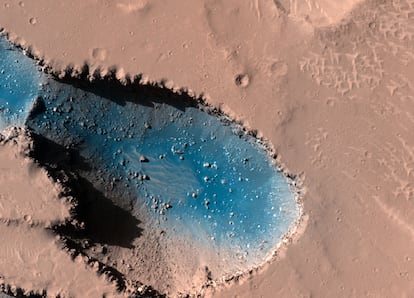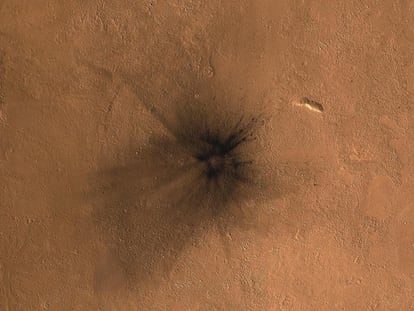New evidence suggests huge volcanic eruption could take place on Mars
Analysis has detected a vast region shaped by ongoing activity, debunking the theory that the planet is dead and opening new possibilities for human exploration and the search for life

Until a few weeks ago, Mars was a dead planet. The last volcanic eruptions there took place billions of years ago and the vast majority of experts believed that since then, the bowels of the planet have been practically motionless.
However, a groundbreaking study published Monday has completely altered this view. The paper analyzes data from several orbital probes and also dozens of marsquakes captured by Insight, the NASA spacecraft perched near the equator of the Red Planet, which was the first satellite to record seismic movements on Mars.
The conclusions of the study are conclusive: the subsoil of Elysium Planitia, one of the largest Martian plains, contains an area displaying volcanic activity spanning a diameter of about 4,000 kilometers (2,485 miles), an area similar to the size of Western Europe. The study notes that Mars has now become the third planet in the interior of the Solar System with known active volcanism, together with Earth and Venus.
The work was carried out by Adrien Broquet and Jeff Andrews-Hanna, scientists at the Lunar and Planetary Laboratory of the University of Arizona. Both analyzed different sets of data recorded by probes that spent decades analyzing the Red Planet, such as NASA’s Mars Global Surveyor and Mars Reconnaissance Orbiter.
Together with other missions, these analyses have made it possible to compose detailed topographic maps, as well as to study changes in the gravitational pull exerted by the planet, which depends on the composition of both the surface and the core layers. Adding Insight’s recent findings, both researchers conclude that the most plausible explanation for the seismic activity is the existence of a huge mantle plume in this part of Mars - a large rock conduit connecting the planet’s lower mantle with its outer crust.
The plume is 100º to 300º degrees Celsius (212º to 572º degrees Farenheit) hotter than the rest of the planet, so despite being in a solid state, it flows slowly upward. The head of this plume is thought to be between 25 and 200 kilometers deep. Were it to reach a distance of about 10 kilometers from the surface, the plume could heat the crust to melting point, causing a lava eruption. According to the authors of the study, published in Nature Astronomy, the high seismic activity captured by Insight indicates that this area “is active” and that there may already be lava deposits in the subsurface.
Broquet explains: “In other work by our group we have found the most recent instance of volcanism in the history of Mars; a small ash deposit of about 20 kilometers in diameter right in the center of the mantle plume. It is about 50,000 years old, which is to say yesterday in geological terms. All this tells us that this region is active today.”

“Our finding implies that there could be an eruption on Mars”
In 1990, a team of scientists simulated a mantle plume using a box filled with syrup of different densities. One of the shapes created resembles what must be happening now in Mars’ crust, with the rounded head of the plume, resembling a mushroom, pushing through the crust of the Red Planet. Pressure can form magma deposits in the crust and trigger eruptions on geologic time scales, explains Andrews-Hanna, co-author of the paper. “Our finding implies that there could be an eruption on Mars; it could be today or in a million years or so, which is a very short time on these scales. This is certainly the most interesting region on Mars today.”
The pressure of the plume on the planet’s crust has caused a bulging shape in the entire region that rises from the surrounding terrain by one to two kilometers. It has also caused a huge network of cracks and faults known as the Cerberus Trench, the longest of its kind on the planet at about 1,300 kilometers long.
This volcanism on Mars is both similar and different from that of the Earth. The same process of mantle plumes and hot spots occurs in places like Hawaii or the Canary Islands. As on Earth there are tectonic plates that move like huge rafts on the mantle, the plumes cause eruptions that create island chains. On Mars there is no plate tectonics, so possible eruptions are concentrated in a single point.
The mantle plume discovered on Mars is much larger than any that has ever existed on Earth, although its emergence and eruption times are much longer because Mars is colder and has less gravity, being smaller than Earth.
Broquet compares these findings to those of the 1970s, when seismic experiments carried out by the Apollo spacecraft - including setting off bombs - revealed that the Moon was not an inert satellite but harbors a molten rock core. “Most also see Mars as a small, cold, dead world, but the discovery of this large mantle plume is a paradigm shift. No model had predicted the existence of active volcanism on Mars, so we are going to have to rewrite the geological history of the planet to explain how it could have formed.”
The new data implies that Insight is hovering over the volcanic plume, although this may not alter its fate much. The spacecraft is at the western end of the active zone, far from its center, and lava would flow eastward, making it unlikely that an eruption could damage it in any way. “Our plans are not going to change much,” says Simon Stahler, a geophysicist at the Swiss Federal Institute of Technology involved in the Insight mission. “The probe is about to run out of power because of accumulated dirt on the solar panels. What we can do until the batteries die is to re-evaluate our way of measuring earthquakes to account for the existence of this plume. Seismic waves propagate faster when the ground is cold. Until now we assumed that the temperature was uniform, but now we know that there is a large warmer zone.”
On Earth, volcanism is one of the major drivers of climate change and natural disasters. The extinction of the dinosaurs some 65 million years ago is thought to have been due in part to a massive eruption that lasted nearly a million years and cooled the Earth. This, Stahler says, would be “impossible” on Mars, because volcanism there is too slow. “In any case, it is an important discovery to find that the planet is not dead,” he adds.
The study carries two important implications for future robotic and human exploration on Mars. It is thought that if there is life on the Red Planet, it has to be in the form of microbes sheltering beneath the surface to escape the high radiation. The fact that there is volcanism and higher temperatures may make this a more hospitable area for such organisms and therefore a good place to send future robotic missions. This new information is also likely to influence the design of future manned missions to Mars: Elysium Planitia is currently the only known place where a functional geothermal base could be created to provide heat and energy for astronauts.
Sign up for our weekly newsletter to get more English-language news coverage from EL PAÍS USA Edition
Tu suscripción se está usando en otro dispositivo
¿Quieres añadir otro usuario a tu suscripción?
Si continúas leyendo en este dispositivo, no se podrá leer en el otro.
FlechaTu suscripción se está usando en otro dispositivo y solo puedes acceder a EL PAÍS desde un dispositivo a la vez.
Si quieres compartir tu cuenta, cambia tu suscripción a la modalidad Premium, así podrás añadir otro usuario. Cada uno accederá con su propia cuenta de email, lo que os permitirá personalizar vuestra experiencia en EL PAÍS.
¿Tienes una suscripción de empresa? Accede aquí para contratar más cuentas.
En el caso de no saber quién está usando tu cuenta, te recomendamos cambiar tu contraseña aquí.
Si decides continuar compartiendo tu cuenta, este mensaje se mostrará en tu dispositivo y en el de la otra persona que está usando tu cuenta de forma indefinida, afectando a tu experiencia de lectura. Puedes consultar aquí los términos y condiciones de la suscripción digital.
More information
Últimas noticias
The complicated life of Francesca Albanese: A rising figure in Italy but barred from every bank by Trump’s sanctions
Reinhard Genzel, Nobel laureate in physics: ‘One-minute videos will never give you the truth’
Pinochet’s victims grapple with José Antonio Kast’s rise in Chile
Half of Scotland is in the hands of 420 property owners
Most viewed
- Pablo Escobar’s hippos: A serious environmental problem, 40 years on
- Why we lost the habit of sleeping in two segments and how that changed our sense of time
- Trump’s obsession with putting his name on everything is unprecedented in the United States
- Charles Dubouloz, mountaineering star, retires at 36 with a farewell tour inspired by Walter Bonatti
- The Florida Keys tourist paradise is besieged by immigration agents: ‘We’ve never seen anything like this’










































